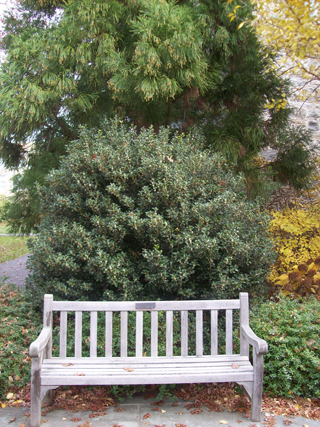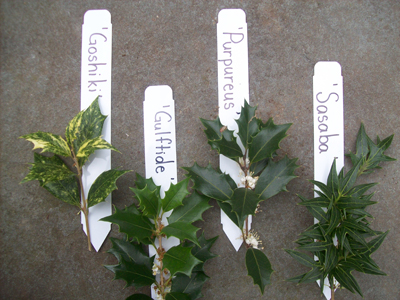Holly Osmanthus

The fragrance conjured notes of jasmine and citrus. As I looked around the plantings in front of the Lang Performing Arts Center, I tried to make a mental list of plants in bloom during November. The few that I could name didn’t possess such a powerful perfume. Eventually I came upon a rounded, evergreen shrub with holly-like leaves. Petite white blooms covered the plant. Before me was the Holly Osmanthus, Osmanthus heterophyllus ‘Gulftide’.

Cultivars of Osmanthus heterophyllus. photo credit: J. Coceano
Inspection of the plant’s Latin name gives insight into its defining features. Osmanthus is derived from the Greek word osme, fragrance, and anthos, flowers. In autumn, white flowers are borne within the leaf axils. While small, great quantities are produced resulting in a permeating fragrance in its surroundings. The specific epithet, heterophyllus, translates to “variable leaves.” A single plant may have juvenile and mature leaves. Juvenile leaves bear 1 to 4 pairs of prominent spiny teeth. As osmanthus matures, adult leaves appear. Mature leaves loose the spines and become entirely oval or ovate in shape.
A versatile landscape plant, Osmanthus heterophyllus is an ideal candidate for borders, screens, hedges or as a specimen plant. Choose a location with fertile, well-draining soil in full sun to partial shade. Holly osmanthus averages 8’ to 20’ in height, but is easily maintained through pruning. Deer browse rarely occurs and the species has no major pest or disease problems.

Osmanthus heterophyllus 'Sasaba' photo credit: J. Coceano
Several cultivars for consideration include: ‘Goshiki’ sports green flecks against a creamy golden background. ‘Gulftide’ exhibits glossy green foliage with an upright form. New growth on ‘Purpureus’ emerges black-purple and is considered the most cold hardy. ‘Sasaba’ bears deeply cut, incised dark green leaves.





Eunice Silver
Posted at 14:41h, 01 DecemberThe fragrance is absolutely delicious! And it lasts a long time when boughs are cut and brought indoors.